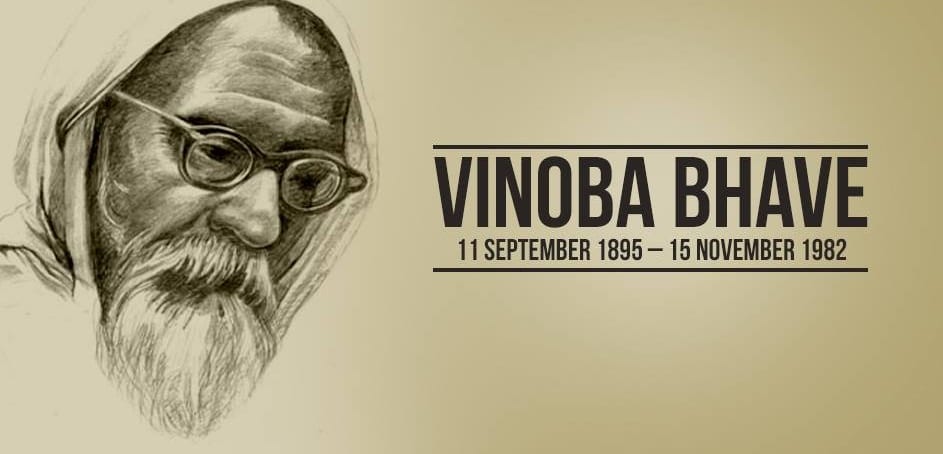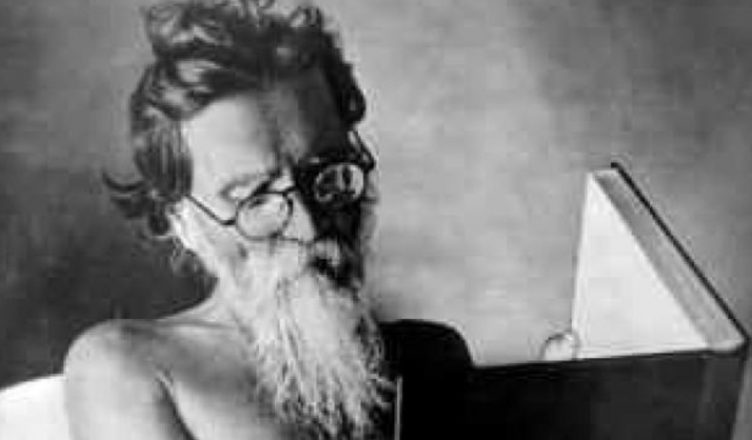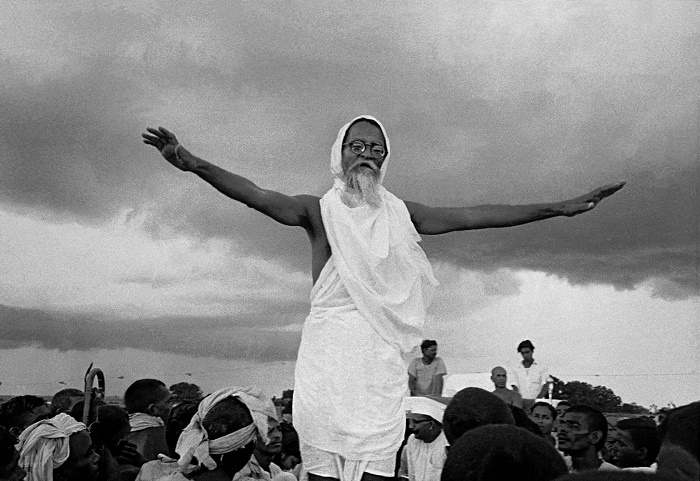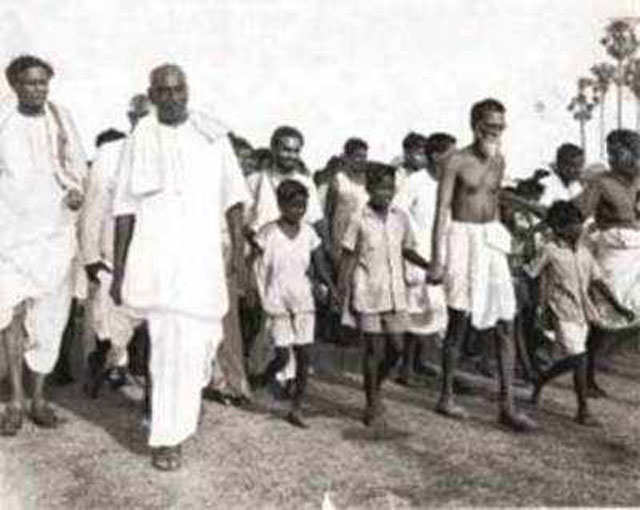Stories
Vinoba Bhave, The Walking Saint of India

Famous for his “Sarvodaya and Bhoodan movements in India, Vinoba Bhave was an eminent freedom fighter and social reformer; an educated writer and philosopher; a staunch believer in Gandhiji’s ideas of non-violence and humanism; a saintly personality who lead a spiritual life at the Paunar Ashram in Maharashtra. Vinoba who launched to revolutionary movements – ‘The Sarvodaya and Bhoodan’ considered all revolutions as spiritual at source. He said, “All my activities have the sole purpose of achieving a union of hearts.”

Vinoba Bhave, whose full name was Vinayak Narahari Bhave, was born on 11th September 1895 in high ranking Chitapavan Brahmin family in Gacoda, a village in the district of Kolaba of Maharashtra. His mother, Rukmini Devi was largely responsible for his early education and spiritual growth. It was under her influence that Vinoba came to read about the writings of all the saints and philosophers of Maharashtra. To fulfill the hunger of his spirit, he spurned college and went to Banaras where he met several scholars and made an extensive study of many Sanskrit texts.
Once Vinoba got a chance to hear Gandhiji’s speech at the Banaras Hindu University. Being very much impressed by it, he wrote a letter to Gandhiji. In reply, Gandhiji invited Vinoba to meet him at Kochrab Ashram in Ahmedabad. On 7th June 1916, Vinoba’s meeting with Gandhi changed the entire course of his life. He was so influenced by the leader’s thinking that he established an unbreakable bond with Gandhiji.

On 8th April 1921, as per Gandhiji’s advice, Vinoba took charge of the ashram at Wardha. Gradually he got involved in Gandhiji’s creative activities like spinning, teaching, reading, and writing and serving the people. Along with Gandhiji, Vinoba had taken part in Salt Satyagraha, Flag Satyagraha, Quit India Movement, etc. In 1932, he was sent to jail by the British Colonial government because of his fight against the British rule. He spent many years in the jail located in Dhulia, Nagpur, Vellore, Seoni, etc. However, jails for him were places for reading and writing. He wrote in the Dhuliya jail, a masterpiece “Gitai”, a Marathi translation of the Gita for his mother who didn’t understand Sanskrit. Lectures given by him to his prison mates in the Dhuliya jail on Gita were later published as a book. These were published in a compiled form under the title “Geeta Pravachan” (talks on the Gita) which was later translated into many Indian and foreign languages too. Vinoba said that his other contributions may be forgotten by the people but his lectures and his books would always be remembered.

In 1938, when he fell sick, he shifted to Paunar ashram at Wardha, which remained his headquarters. Vinoba was Gandhiji’s favorite disciple whom Gandhi introduced to his countrymen after 1940. Gandhiji initiated him into the Satyagraha movement in 1940 and included him in Quit India Movement two years later. Gandhiji envisaged not only a free India but also the creation of a new social order, different from the capitalist, socialist and communist systems. It was to be a society based on love and human values; decentralized, self-governing and non-exploitative. Its name, Sarvodaya, meant “uplift of all”; a society for the good of all. It means the welfare and prosperity of all. All must progress together without a collision of interest. Sarvodaya aims to put an end to all exploitation and inequality and goes on step ahead of the utilitarian Western concept of democracy which pleads for the “greatest good of the greatest number”. After the death of Gandhiji, Vinoba decided to fulfill the dream of Gandhiji and take ahead his concept of Sarvodaya.

Vinoba felt that the average villager in India led a very deprived life and so he tried to find the solution to the problem on the basis of a firm spiritual foundation. This formed the core of his Sarvodaya and Bhoodan movement. As a part of the movement, he traveled on foot from village to village; appeal to the landlords donate part of the land for the landless. This land donation mission “Bhoodan” began in April 1951 at Pochampalli village of Nalgonda district in Andhra Pradesh. Vinoba’s appeal moved landlord Ramachandra Reddy of his village who came forward to sign a deed of donation of hundred acres of land and thus the Bhoodan movement was born. Between 1951 and 1970, he collected 4.2 million acres of land from about the million donors, to be distributed to landless families. He walked twelve to fifteen miles a day from village to village at his evening meetings, along with bhajans and prayers, he spoke to thousands. Some walked many miles to see this holy man. Others came with their families in bullock carts to get a glimpse of him. To those gathered here often said I have come to rob you with love. I want you to change your heart and path with your surplus land so that those who haven’t any can get it. The result of this movement was an achievement of gigantic proportions, a miracle in the history of mankind.
In 1958 he was awarded the Magsaysay Award, considered as the Asian Nobel Prize for his Novel Bhoodan and Sarvodaya Movement. In the year 1983, he was posthumously awarded the Bharat Ratna, the highest civilian honor in India. The strength of Vinoba’s sincerity and love for humanity can be gauged from the fact that he went to the notorious Chambal valley and succeeded in changing the hearts of 19 dacoits who surrendered to him. So inspired were they by Vinoba, that of their own accord they readily laid down their arms and agreed to come to live in the mainstream of the society. After 1970 he withdrew from active life and announced his intention to stay only at Paunar where he observed a year’s silence from 25th December 1974 to 25th December 1975. As a staunch follower, of Gandhiji, he was the non-controversial supporter of the Congress party. But when Prime Minister Indira Gandhi imposed a state of Emergency in 1975, striking a severe blow to democracy, Vinoba endorsed this action of Indira Gandhi and called it the “Anushasan Parva”. This dragged him into a controversy as his spiritual believes and social concern came to be looked upon with skepticism.

Vinoba was the earliest reformer of India to speak about Stree Shakti or women’s power. He wanted them to realize their own power and use it constructively. He had started Bramha Vidya Mandir for women for group activities.
He was a prolific writer who had written many books in Hindi and Marathi and translated many religious Sanskrit texts to make them accessible to the common man. He was the linguist with an excellent command of Marathi, Hindi, Sanskrit, and Urdu language. He wrote criticisms of several religious works like the Vedanta, the Bible and the Quran which shows his respect and love for all religions. You also expressed his political views and publications like this Teesri Shakti (Third power) and Swaraj Shastra (political treatise)

In November 1982, Vinoba fell seriously ill. He decided to give up his life and refused to take food, water or medicine. At the age of 88, on November 15th, 1982 he breathed his last at Paunar Ashram. Vinoba Bhave was indeed the unparalleled “Walking Saint” of India who died a peaceful death and left this mortal world to meet his maker.






























